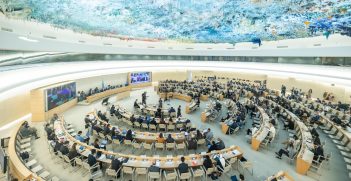Can the TPP Fix the "Noodle Bowl" of Asian Free Trade Agreements?

The Trans-Pacific Partnership (TPP) is one of the most significant developments in Australia’s trade and foreign policy agendas. However a critically important question has been overlooked: what effect will the TPP have on the trade architecture of our region?
Since negotiations were completed in October 2015, a series of lively policy debates have weighed the merits of the agreement. Most have focussed on the benefits and costs of the agreement for Australia itself, including questions over investor-state dispute settlement, the extent of market access gains and the impact of new copyright and pharmaceutical rules.
It is equally important, however, also to examine the impact of the TPP on the trade architecture of the Asia-Pacific.
The TPP is more than just a set of market access opportunities that need to be balanced against the costs of domestic policy reforms. It also promises wholesale change in the way trade policy in the Asia-Pacific is structured. Understanding its effects on the trade system is essential if we are to properly evaluate its implications for Australia.
The fragmented trade architecture of the Asia-Pacific
In the early years of the 21st century, the trade architecture of the Asia-Pacific was dramatically transformed. Regional governments were previously ‘committed multilateralists’, pursuing trade liberalisation through the WTO at the global level and APEC at the regional level.
But, starting from about the year 2000, Asian governments’ attention turned toward bilateral free trade agreements (FTAs). Simpler to negotiate than multilateral agreements, these bilaterals were seen as a ‘quick and easy’ way to open new export markets. The Asia-Pacific quickly became the epicentre of a global move to trade bilateralism, with the number of FTAs in the region growing to 40 by 2014.
The proliferation of bilateral FTAs has led to a phenomenon trade economists call the “noodle bowl problem”. Rather than having a single, integrated set of trade rules that apply equally to all governments, the region is now criss-crossed by dozens of individual bilateral deals. Compounding matters, the agreements are often wildly inconsistent. Each contains its own rules for tariff reduction, non-tariff trade policy reforms and standards for administrative procedures.
The “noodle bowl” is widely considered to be bad for trade. It undermines the cohesiveness of trade rules and distorts markets. It poses transaction costs for companies, who now have to manage compliance with a wide array of complex international treaties. It also threatens to introduce asymmetries if powerful states are able to demand better deals from certain partners. According to Jagdish Bhagwati, bilateral FTAs are like “termites” undermining the global trade system.
“Multilateralising” the Asian noodle bowl
One of the attractive features of the TPP is that it may help to address the noodle bowl problem. Some have argued the TPP is a first step in returning the regional trade architecture to a multilateral model.
Three features make the TPP particularly suited to this task:
- Its size. The 12-member bloc is not only of regional but global importance. Member states account for just over a quarter of world trade and a third of world GDP and includes economic heavyweights such as Japan and the US. Articulating a single set of trade rules for such a large chunk of the global economy is in itself of systemic importance.
- Its approach to ‘WTO-Plus’ issues. One of the major distortions introduced by bilateral agreements is an inconsistent approach to issues not yet covered by WTO rules. Several of these are in the emerging but critically important domains of trade policy, including financial services, intellectual property, e-commerce and the environment. The TPP is a first step in ensuring regulatory coherence in these new trade policy areas.
- Its status as a ‘living agreement’. Member states have made clear the TPP is not a fixed agreement but a framework for ongoing trade policy reform. The accession of new members is actively encouraged. Canada, Malaysia, Mexico and Japan all joined after negotiations had begun while Korea and Indonesia are currently discussing accession arrangements. Members may also move to refine, expand and add new provisions to the treaty in future years. This makes the TPP a platform through which subsequent liberalisation steps can be negotiated.
Thus, the TPP’s ultimate promise lies in its ability to change the regional trade architecture back towards a multilateral approach. In the long-term, these features may prove far more important than any short-term market access gains. As a small economy that has struggled to obtain decent payoffs from its bilateral FTAs, Australia stands to gain considerably if the TPP sets such a transformation in train.
Can the TPP suck up the noodles?
Of course, the potential systemic effects of the TPP remain just that. The agreement is yet to be ratified and whether it will provide a foundation for a new regional trade system remains an open question. There are a number of obstacles that may undermine its ability to multilateralise trade policy in the Asia-Pacific.
The TPP’s long-term success will ultimately depend on its ability to draw in new members and attain “full” regional coverage. Conspicuous absences currently include Korea, India, Indonesia and China. With its extensive set of WTO-Plus rules, accession is a daunting prospect for developing economies that are usually unwilling to liberalise in these new areas. Chinese membership is also clouded by geopolitics, and the fact the TPP has been labelled a US attempt to ‘economically-encircle’ China.
The TPP also faces competition from the Chinese-led Regional Comprehensive Economic Partnership (RCEP) agreement. RCEP also promises to fix the regional noodle bowl, by uniting the six existing ‘ASEAN-Plus-X’ FTAs under a single umbrella. However, as it lacks the WTO-Plus requirements insisted upon by the US, RCEP is more attractive to developing country governments. It also counts India and China as members, but lacks the US. Much will depend on whether RCEP negotiations produce a result in 2016, as has been promised.
Finally, what of global-level trends in trade policy at the WTO? With the mandate underpinning the WTO’s Doha Round recently collapsing, it remains unclear precisely where liberalisation efforts will go next. It is possible the failure of Doha may drive renewed interest in regional agreements such as the TPP and the related EU-US TTIP agreement. But it might equally lead to yet another push for quick and easy bilaterals, further compounding the noodle bowl problem.
Much will depend on how smoothly the TPP ratification process proceeds in 2016 and whether members can then get on with growing this living agreement.
Dr Jeffrey Wilson is a Research Fellow at the Perth USAsia Centre. This article was published under a Creative Commons Licence. It may be republished with permission.





